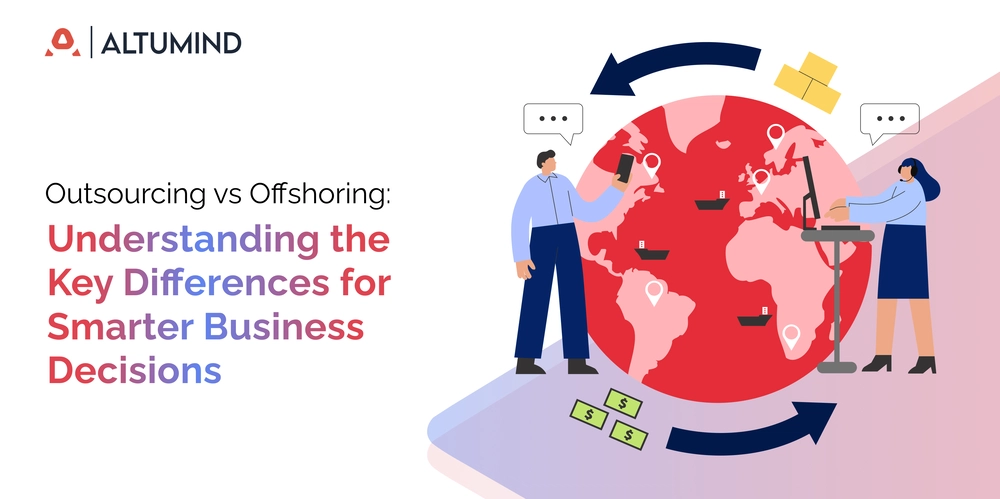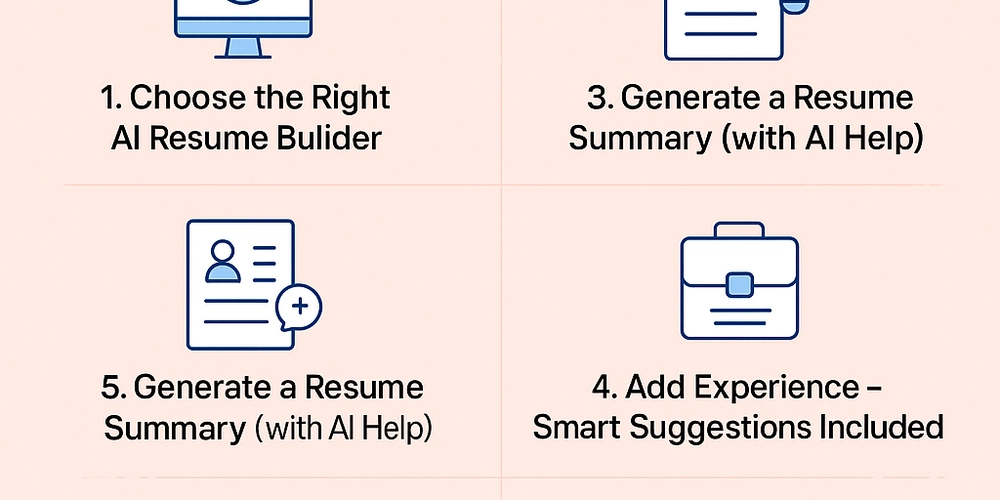Outsourcing vs Offshoring: Understanding the Key Differences for Smarter Business Decisions
The relentless competitiveness and cost-cutting exercises have led to the creation of global talent delivery models in emerging economies — Outsourcing and Offshoring. At the heart of both lies a steady pursuit of increased output and savings. Despite the overlap in key drivers, these two aren’t the same. Their underlying principles may mimic, but they differ in execution. Both, matured and evolved and deeply entrenched in the business strategies of companies worldwide are poised to get stronger — as more talent bases come up in far-off regions. But, which one makes sense for your business? Today, in this write-up we’ll explore the two concepts in detail and understand which model fits your unique business goals. Let’s get started. What is Outsourcing? Outsourcing is when a company assigns some tasks to external parties rather than performing them in-house. This approach allows companies to leverage specialized expertise, reduce costs, and improve efficiency by focusing on their core competencies while external vendors handle non-essential secondary activities 76% of the companies attributed lower costs as one of the top reasons for outsourcing — PWC Outsourcing can be done locally or internationally, depending on the business needs. Successful outsourcing requires meticulous vendor selection, clear communication, a competent talent pool, and robust management to ensure quality and alignment with the company’s objectives. Access to talent, capabilities, low-cost options, and business flexibility make outsourcing a value-driven model. What is Offshoring? Offshoring is when a company relocates its business processes or operations to another country to benefit from cost differentials and access specialized skills. The primary motivation is cost reduction, as North American and European companies benefit from dollar arbitrage in the host country — leading to lower costs and improved profit margins. However, offshoring can also help access a broader talent pool and potentially spread your footprint into new markets. It requires careful vendor selection, transparent contracts, crystal-clear dialogue, a diverse talent bench, culture sync, and sturdy management to sustain the operations. Generally, offshoring allows more permanency, culminating in long-term partnerships with the service provider. Key Differences Between Outsourcing and Offshoring Region in Question In outsourcing the services can be provided onshore, in the same region as the business, or on another continent. It doesn’t impose any location restrictions. But, offshoring as the word suggests is always performed in a distant geographic region far from where the company is located. So, often distance is considerably greater when it comes to offshoring. Cultural Barriers Seeing as outsourcing can be performed in the region you are in, cultural barriers, such as traditions and social references shouldn’t be an issue, but only if it is carried out onshore. The moment you take the task to a nearby or distant vendor, cultural differences become more pronounced. With Offshoring you’ll always need to factor in the cultural element. Cost Savings Companies stand to profit more when activities are performed by resources living abroad. If outsourcing was performed onshore, the cost-benefit may be much less. But, if done in another region, the economics may work out to what offshoring can provide. In that case, offshoring doesn’t hold a significant monetary advantage. Time Zones Outsourcing if performed by a vendor in the same region will not result in a time zone difference, but as you start moving further it will become an issue. Offshoring generally brings up significant time zone differences, but companies nowadays offer enough flexibility to get resources to adjust and sync with the client’s preferred time. Flexibility to Switch Generally, outsourcing contracts are more fluid and flexible. Overall, outsourcing imposes fewer restrictions. Offshoring though may require setting up a dedicated infrastructure and teams, making it a bit more rigid — you can’t cut off and walk away that easily. Off-late offshoring is becoming nimbler in how it handles its vendors, but due to a limited lock-in period in outsourcing, it ends up having the edge. Extent of Control In offshoring, the company maintains more control over operations since it often involves setting up a subsidiary or branch. Outsourcing on the other hand shows more reliance on third-party vendors, with less direct control over day-to-day operations. But, depending on the nuances of the engagement model, offshoring/outsourcing controls can vary significantly. Scope of Work Offshoring typically involves relocating entire departments or extensive business processes to another country. This might include moving an entire IT support function overseas. On the other hand, outsourcing usually focuses on specific tasks or functions, delegating them to an external company specializing in those areas.

The relentless competitiveness and cost-cutting exercises have led to the creation of global talent delivery models in emerging economies — Outsourcing and Offshoring. At the heart of both lies a steady pursuit of increased output and savings. Despite the overlap in key drivers, these two aren’t the same. Their underlying principles may mimic, but they differ in execution.
Both, matured and evolved and deeply entrenched in the business strategies of companies worldwide are poised to get stronger — as more talent bases come up in far-off regions. But, which one makes sense for your business? Today, in this write-up we’ll explore the two concepts in detail and understand which model fits your unique business goals. Let’s get started.
What is Outsourcing?
Outsourcing is when a company assigns some tasks to external parties rather than performing them in-house. This approach allows companies to leverage specialized expertise, reduce costs, and improve efficiency by focusing on their core competencies while external vendors handle non-essential secondary activities
76% of the companies attributed lower costs as one of the top reasons for outsourcing — PWC
Outsourcing can be done locally or internationally, depending on the business needs. Successful outsourcing requires meticulous vendor selection, clear communication, a competent talent pool, and robust management to ensure quality and alignment with the company’s objectives. Access to talent, capabilities, low-cost options, and business flexibility make outsourcing a value-driven model.
What is Offshoring?
Offshoring is when a company relocates its business processes or operations to another country to benefit from cost differentials and access specialized skills. The primary motivation is cost reduction, as North American and European companies benefit from dollar arbitrage in the host country — leading to lower costs and improved profit margins.
However, offshoring can also help access a broader talent pool and potentially spread your footprint into new markets. It requires careful vendor selection, transparent contracts, crystal-clear dialogue, a
diverse talent bench, culture sync, and sturdy management to sustain the operations. Generally, offshoring allows more permanency, culminating in long-term partnerships with the service provider.
Key Differences Between Outsourcing and Offshoring
Region in Question
In outsourcing the services can be provided onshore, in the same region as the business, or on another continent. It doesn’t impose any location restrictions. But, offshoring as the word suggests is always performed in a distant geographic region far from where the company is located. So, often distance is considerably greater when it comes to offshoring.
Cultural Barriers
Seeing as outsourcing can be performed in the region you are in, cultural barriers, such as traditions and social references shouldn’t be an issue, but only if it is carried out onshore. The moment you take the task to a nearby or distant vendor, cultural differences become more pronounced. With Offshoring you’ll always need to factor in the cultural element.
Cost Savings
Companies stand to profit more when activities are performed by resources living abroad. If outsourcing was performed onshore, the cost-benefit may be much less. But, if done in another region, the economics may work out to what offshoring can provide. In that case, offshoring doesn’t hold a significant monetary advantage.
Time Zones
Outsourcing if performed by a vendor in the same region will not result in a time zone difference, but as you start moving further it will become an issue. Offshoring generally brings up significant time zone differences, but companies nowadays offer enough flexibility to get resources to adjust and sync with the client’s preferred time.
Flexibility to Switch
Generally, outsourcing contracts are more fluid and flexible. Overall, outsourcing imposes fewer restrictions. Offshoring though may require setting up a dedicated infrastructure and teams, making it a bit more rigid — you can’t cut off and walk away that easily. Off-late offshoring is becoming nimbler in how it handles its vendors, but due to a limited lock-in period in outsourcing, it ends up having the edge.
Extent of Control
In offshoring, the company maintains more control over operations since it often involves setting up a subsidiary or branch. Outsourcing on the other hand shows more reliance on third-party vendors, with less direct control over day-to-day operations. But, depending on the nuances of the engagement model, offshoring/outsourcing controls can vary significantly.
Scope of Work
Offshoring typically involves relocating entire departments or extensive business processes to another country. This might include moving an entire IT support function overseas. On the other hand, outsourcing usually focuses on specific tasks or functions, delegating them to an external company specializing in those areas. An entire operational shift is less common in outsourcing and more prominent in offshoring arrangements.
Outsourcing and Offshoring: Which one is best for your business?
The choice between outsourcing and offshoring comes down to your priorities, such as cost efficiency, expertise, operational flexibility, and control. On projects where you can afford to partner with vendors nearby or on the same continent and cost isn’t such a factor, opt for outsourcing. But if cost is a burden then offshoring makes more sense.
Sometimes talent isn’t easily available in proximity and going abroad means a simple outsourcing strategy may not work. Offshoring makes more sense here, seeing as you are looking to forge long-term concrete alliances with talent providers to configure/oversee teams that serve as an extension to your in-house talent — it isn’t a one-and-done project, you are in for the long haul.
There are times when companies wish to establish a capability center or even a delivery center abroad.
Setting up a subsidiary or branch office in a foreign country requires more than just a simple linear outsourcing approach. You aren’t just allocating work and stepping back. An offshoring strategy where you can fine-tune the minuscule aspects of the team seems more suitable.
An informed decision must align with your strategic immediate, and distant business goals. Thus, the best model will always be the one that best suits your unique needs and limitations.
What Are the Different Factors You Must Consider?
Local Labor Laws: Delegating work to another organization, in another region requires you to comply with their laws. Vigorously study the customs, standards, best practices, and other protocols. The labor laws in North America could differ from the ones valid in South Asian Countries. There may surely be some overlap, but there could also be a significant amount of polar opposite laws for the rights and entitlements of the resources.
Data Compliance: Each country has data protection laws that dictate how the same is collected, processed, and stored. Be aware of cross-border data transfer laws and ensure your offshoring/outsourcing provider complies with these stringent laws. Look for talent providers with relevant certifications like ISO 27001, PCI DSS, SOC 2, and more. Companies must adhere to regulations, from GDPR to PDPA to CCPA and India’s DPDP Act, or risk fines or litigations.
Data Security: Only collaborate with partners using robust encryption and data protection measures. Define and monitor who has access to your data, from 2-factor authentication to role-based access, the sensitive data must only be accessible to users part of the project through access control policies. Any unauthorized access must trigger an alert so immediate action can be taken to prevent any data leaks. It’d be great if they had enough insurance and liability coverage for data loss or damage.
NDA: Non-disclosure agreements and other plagiarism clauses in contracts are equally pivotal. You don’t want your Intellectual Property (IP), trade secrets, and other sensitive data to end up in the public domain. Clearly define the scope & ownership and outline the responsibilities of the people involved. Further, stress plagiarism and implement strict copyright laws to avoid infringing on the property rights of others.
Economic and Social Conditions: Check the societal stability and overall sentiment. The last thing you want is day-to-day conflicts, strikes, and political strife affecting business continuity. Check tariffs, trade barriers, geopolitical policies in place, country relations, and restrictions. Strained dynamics can lead to barriers, making smooth operations and ease of doing business hard. Also, keep track of sudden economic shifts that could affect currency, taxes, incentives, inflation, and final costs.
Infrastructure Strength: A quality IT ecosystem of hardware, software, network, etc. facilitates seamless, safe, and sustainable operational efficiency. The talent provider must have a potent and stable infrastructure. From reliable workstations to 24/7 power, servers, high-speed internet connectivity, furniture, peripherals, biometrics, and more. Further, the overall ambiance of the office space must be conducive to complex work.
Expert Talent Pool: Assess whether the region has enough resources for the technical expertise you seek. Having a vast talent pool gives you a stronger buffer when drop-outs happen. Also, a place that provides more diversity in roles, allows you to have a team of varying qualifications and experience — from amateurs to seasoned experts. Generally, regions with stronger universities and training centers tend to have more qualified candidates.
What Services are covered in Outsourcing and Offshoring
Simple tasks such as data entry, transcription, phone customer support, chat support, etc. often fall into the outsourcing net. In some cases, if the IT ticket support volume is less or cosmetic QA checks are all you need — outsourcing may be the way to go. Outsourcing is the right approach for rudimentary activities where the learning curve is short and generic talent can easily handle the requirements.
Heavy-duty software development, managing cloud infrastructure, setting up data centers, creating an innovation lab, providing 24/4 support, etc. is more suited to the offshoring model. Anything that requires a great extent of training, workshops, niche talent, or where the scale of work is huge is more cut out for offshoring. Offshoring can be looked at as a more seasoned version of outsourcing.
Wrapping Up
Offshoring is the best way forward for full-fledged operations requiring deeper integration with the tech teams. It allows greater control over the quality and company-specific processes. But, if long-term strategic gains are not on the menu and immediate access and cost savings for short-term projects are all you are after, outsourcing may be a better option.
82% of the companies identified standardization and efficiency of resources as an objective achieved by outsourcing to another company — Deloitte
The one service that adapts intelligently to offshoring demands is Agiliti. A talent-rich yet affordable resource augmentation model that will recruit and manage resources for any IT necessity. From web development to data analytics, Agiliti fulfills every business requirement, acting as a one-stop shop for all your unique needs. So, what are you waiting for, reach out to us today!




























![[Webinar] AI Is Already Inside Your SaaS Stack — Learn How to Prevent the Next Silent Breach](https://blogger.googleusercontent.com/img/b/R29vZ2xl/AVvXsEiOWn65wd33dg2uO99NrtKbpYLfcepwOLidQDMls0HXKlA91k6HURluRA4WXgJRAZldEe1VReMQZyyYt1PgnoAn5JPpILsWlXIzmrBSs_TBoyPwO7hZrWouBg2-O3mdeoeSGY-l9_bsZB7vbpKjTSvG93zNytjxgTaMPqo9iq9Z5pGa05CJOs9uXpwHFT4/s1600/ai-cyber.jpg?#)













































































































































![[The AI Show Episode 144]: ChatGPT’s New Memory, Shopify CEO’s Leaked “AI First” Memo, Google Cloud Next Releases, o3 and o4-mini Coming Soon & Llama 4’s Rocky Launch](https://www.marketingaiinstitute.com/hubfs/ep%20144%20cover.png)




































































































































































































![Rogue Company Elite tier list of best characters [April 2025]](https://media.pocketgamer.com/artwork/na-33136-1657102075/rogue-company-ios-android-tier-cover.jpg?#)








































































_Andreas_Prott_Alamy.jpg?width=1280&auto=webp&quality=80&disable=upscale#)




























































































![What’s new in Android’s April 2025 Google System Updates [U: 4/18]](https://i0.wp.com/9to5google.com/wp-content/uploads/sites/4/2025/01/google-play-services-3.jpg?resize=1200%2C628&quality=82&strip=all&ssl=1)










![Apple Watch Series 10 Back On Sale for $299! [Lowest Price Ever]](https://www.iclarified.com/images/news/96657/96657/96657-640.jpg)
![EU Postpones Apple App Store Fines Amid Tariff Negotiations [Report]](https://www.iclarified.com/images/news/97068/97068/97068-640.jpg)
![Apple Slips to Fifth in China's Smartphone Market with 9% Decline [Report]](https://www.iclarified.com/images/news/97065/97065/97065-640.jpg)


































































































































